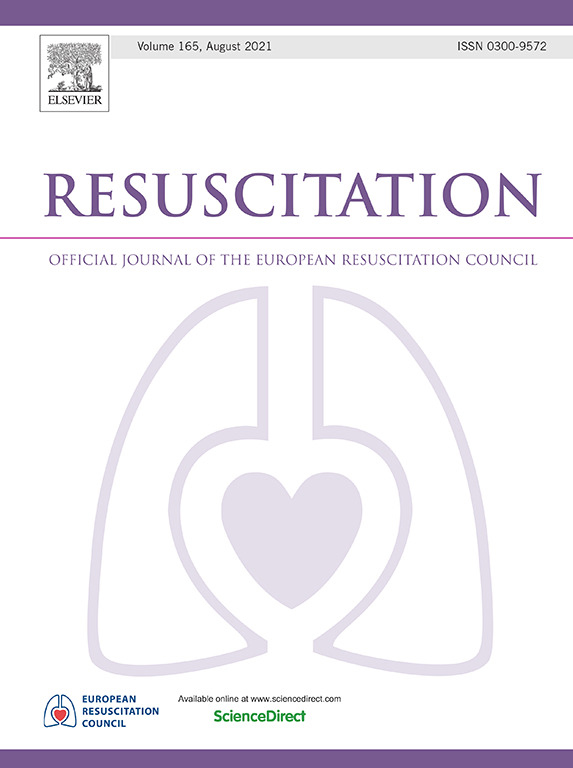Systemic administration of allogeneic mesenchymal stem cells attenuates post-resuscitation left ventricular dysfunction in a porcine model of cardiac arrest
IF 4.6
1区 医学
Q1 CRITICAL CARE MEDICINE
引用次数: 0
Abstract
Background
Based on evidence that a systemic inflammatory response exacerbates multi-organ injury after resuscitation from cardiac arrest (CA), we tested the efficacy of allogeneic mesenchymal stem cell (MSC) administration early after return of spontaneous circulation (ROSC) in a porcine model of CA.
Methods
Swine (n = 33) were subjected to 10-min CA followed by mechanical CPR with defibrillation and intravenous epinephrine (EPI; 0.015 mg/kg). Animals that achieved ROSC (n = 19) were blindly randomized to intraventricular saline (n = 9) or allogeneic bone marrow-derived MSCs (55 ± 2 × 106; n = 10) 30-min post-ROSC. Intravenous EPI was given during the post-ROSC period as needed to maintain MAP ≥ 60 mmHg. Echocardiography, hemodynamic analysis, and serial blood sampling were performed for 4-hours post-ROSC, at which time the heart and brain were collected for post-mortem analysis of inflammation and injury.
Results
Compared with saline-treated controls, MSC-treated animals exhibited improved post-ROSC LV function and lower cTnI levels, indicative of reduced myocardial injury. By design, both groups had a similar post-ROSC blood pressure and cardiac output, but the saline group required significantly more EPI. Allogeneic MSCs also decreased plasma reactive oxygen species and tended to attenuate the post-ROSC rise in circulating IL-6.
Conclusions
Early post-ROSC delivery of allogeneic MSCs attenuates LV dysfunction and reduces the need for pharmacologic hemodynamic support after CA in swine, suggesting that systemic MSC administration may be an effective strategy to improve patient outcomes after resuscitation from CA.
在猪心脏骤停模型中,全身给予同种异体间充质干细胞可减轻复苏后左心室功能障碍。
背景:基于系统性炎症反应加剧心脏骤停(CA)复苏后多器官损伤的证据,我们在猪CA模型中测试了自发循环恢复(ROSC)后早期给予同种异体间充质干细胞(MSC)的疗效。方法:猪(n=33)接受10分钟的CA,然后进行机械心肺复苏,除颤和静脉注射肾上腺素(EPI);0.015毫克/公斤)。获得ROSC的动物(n=19)被随机随机分到脑室盐水组(n=9)或同种异体骨髓来源的MSCs组(55±2 × 106;n=10) rosc后30分钟。rosc后给予静脉注射EPI以维持MAP≥60 mmHg。rosc后4小时进行超声心动图、血流动力学分析和连续采血,此时采集心脏和大脑进行死后炎症和损伤分析。结果:与盐水处理的对照组相比,msc处理的动物表现出改善的rosc后左室功能和较低的cTnI水平,表明心肌损伤减轻。通过设计,两组rosc后血压和心输出量相似,但生理盐水组需要明显更高的EPI。同种异体间充质干细胞还能降低血浆活性氧,并倾向于减弱rosc后循环IL-6的升高。结论:rosc术后早期给予同种异体间充质干细胞可减轻猪CA后左室功能障碍,减少对药理学血流动力学支持的需求,这表明系统给药MSC可能是改善CA复苏后患者预后的有效策略。
本文章由计算机程序翻译,如有差异,请以英文原文为准。
求助全文
约1分钟内获得全文
求助全文
来源期刊

Resuscitation
医学-急救医学
CiteScore
12.00
自引率
18.50%
发文量
556
审稿时长
21 days
期刊介绍:
Resuscitation is a monthly international and interdisciplinary medical journal. The papers published deal with the aetiology, pathophysiology and prevention of cardiac arrest, resuscitation training, clinical resuscitation, and experimental resuscitation research, although papers relating to animal studies will be published only if they are of exceptional interest and related directly to clinical cardiopulmonary resuscitation. Papers relating to trauma are published occasionally but the majority of these concern traumatic cardiac arrest.
 求助内容:
求助内容: 应助结果提醒方式:
应助结果提醒方式:


